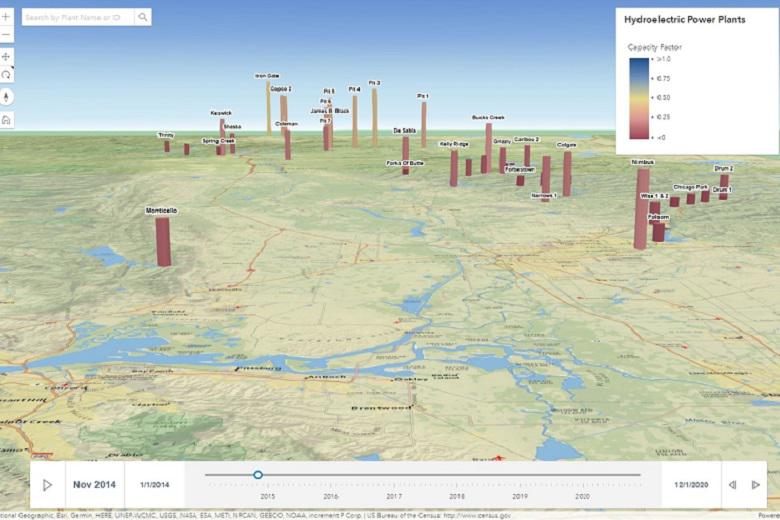The visualization shows generation, including pumped storage projects of at least 10 MW with their capacity factors (CF), on a base map of rivers, lakes, topographic features, and major roadways. California county boundaries are also displayed for reference.

Hydroelectric Power Plants
The visualization tool can be viewed using current versions of Chrome and Firefox web browsers. If you have trouble viewing the map content, a tabular format of the data is available.
How to Use the Tool
1. Click on the hyperlink shown on the page.
2. Follow the tips listed below.
3. The visualization loads with navigation and zooming tools on the left-hand side, a search bar in the top left of the page, and a legend in the top right.
4. The bottom panel contains the time slider widget, which allows the user to step through and view the power plant’s CF in each monthly time frame.
5. By pressing the play button, the user can also let the data automatically cycle through the complete time range.
6. The legend may be expanded (default view) or contracted to maximize screen space for the display of the map.
7. The user may search for a plant by name or CEC Plant ID in the search bar. The search bar also supports a query of the plant’s Resource ID (from the California Independent System Operator, CAISO) or the US Energy Information Administration’s (EIA) plant ID.
8. The bottom-most icon in the left side of the screen reverts the map to its original view of a two-dimensional map centered on California.
9. By hovering over a plant, its CF is displayed at the current time step shown in the time slider. Clicking on the plant shows the pop-up which contains the plant’s capacity, net energy output, and its calculated CF value.
10. A link to the original data source is also provided.
About the Tool
The height and color of columns at project locations are scaled and shaded to represent CFs of the projects in a specific month and year. (Capacity factor is the ratio of the energy produced to the amount that could ideally have been produced in the same period using the nameplate capacity.) The capacity used is the annually reported capacity from the Quarterly Fuel and Energy Report (CEC-1304). The data includes hydroelectric plants that generated in the month displayed. Generation data is as reported in QFER reports to the CEC. Some hydroelectric generators can run at more than nameplate capacity, and the CF can be over 100 percent in some months.
Several hydroelectric plants operate as pumped storage plants, and the net energy consumed for pumping is displayed as a negative CF, also based on the nameplate capacity. Plants with negative factors in a month appear as columns below the map surface.
Renewable energy resources like these hydroelectric facilities vary in size and geographic distribution within each state. Resource planning, land use constraints, climate zones, and weather patterns limit availability of these resources and where they can be developed. National, state, and local policies also set limits on energy generation and use. An example of resource planning in California is the Desert Renewable Energy Conservation Plan.
By exploring the visualization, a viewer can gain a three-dimensional understanding of seasonal variation in generation CFs, along with the locations and distribution of generation projects. Moving through the 3-D space gives a conception of generation CFs across the state. The viewer can observe that projects peak in generation and energy consumption in different months, depending on where and how they are operated. The large range in CFs is also apparent.
References
The interactive map visualization and data analysis are created by CEC staff. Values displayed are subject to revision when more accurate data is available.
For further information, contact qfergen@energy.ca.gov.
